
Overlooking FMCSR basics can put your safety, license, and income at stake; knowing hours-of-service, vehicle maintenance, and load securement helps you avoid major fines and collisions, pass inspections, and protect your career. By learning key rules you reduce fatigue, minimize roadside breakdowns, and demonstrate compliance to carriers and regulators, giving you legal protection and safer hauls. Make FMCSR knowledge part of your routine to keep your rig, your load, and your record intact.
Key Takeaways:
- Compliance reduces risk of fines, inspections, and out-of-service orders by following hours-of-service, ELD, vehicle maintenance, and driver qualification rules.
- Proper cargo securement, maintenance, and HOS adherence lower crash risk and protect driver and public safety.
- Knowing FMCSR speeds inspections and roadside stops, supports timely deliveries, and protects insurance coverage and carrier reputation.

Navigating the Regulatory Framework: An Essential Map
You need familiarity with how FMCSA rules, state statutes, and roadside enforcement interact so you can plan routes, rest breaks, and equipment checks that avoid violations. Expect roadside Level I–III inspections, electronic logging reviews, and carrier audits; failing a critical item like brakes or a positive drug/alcohol test can trigger an immediate out-of-service (OOS) order that stops your haul and costs you time and money.
Key Components of FMCSR
Your daily checklist should center on Hours-of-Service limits—11 hours driving, 14-hour duty window, 30-minute break, and 60/70-hour weekly limits—plus the ELD mandate (Dec 18, 2017), driver qualification files, drug/alcohol testing, mandatory pre- and post-trip inspections, and vehicle maintenance standards that inspectors verify during roadside stops.
FMCSR’s Role in Safety and Compliance
FMCSR sets the procedures inspectors and carriers use to prevent crashes: enforcement of HOS via ELDs, drug/alcohol screening that removes impaired drivers (BAC ≥ 0.04 leads to immediate removal), and mechanical standards that reduce failures like brake or tire blowouts. Your compliance directly affects CSA scores, insurance costs, and whether dispatch keeps you moving.
During a roadside Level I inspection, a critical brake or steering defect puts the truck OOS until repaired; a positive drug test or BAC ≥ 0.04 removes the driver and initiates employer reporting and potential referral to a return-to-duty program. Carriers facing repeated violations may get a compliance review, increased audits, or temporary operating restrictions—costly outcomes you can avoid by following FMCSR steps every trip.
Avoiding Costly Penalties: Understanding Your Liability
Know that a single compliance lapse can trigger immediate out-of-service orders, heavy fines, and civil liability that hit your bottom line and reputation. Violations tied to driver logs, cargo securement, or maintenance often lead to inspection downtimes that cost you revenue while fines and litigation expenses pile up. Factor in higher insurance premiums and lost contracts when your CSA scores spike—these downstream costs often exceed the initial penalty by thousands of dollars.
Common Violations and Their Financial Impacts
Frequent violations include hours-of-service/ELD errors, missing or incomplete driver qualification files, brake and tire defects, and drug/alcohol infractions. Fines can range from a few hundred to tens of thousands per violation, while an out-of-service order stops revenue immediately. Repeat offenders face higher insurance rates and contract losses; brokers often reject carriers with poor safety records, translating safety violations into lost lanes and long-term cash flow problems.
Maintaining Compliance to Protect Your Business
Adopt routine compliance habits: run weekly ELD audits, verify DQ files during onboarding, and schedule preventive maintenance to avoid roadside failures. Use telematics to spot HOS violations before they escalate and document repairs to lower dispute risk. These practices reduce inspection failures, limit fines, and help keep your CSA metrics stable so you retain customers and minimize premium increases.
Implement a formal compliance calendar with quarterly internal audits, documented corrective-action plans, and targeted training for new drivers; carriers that audit monthly see fewer roadside failures. Keep electronic copies of vehicle inspection reports and DQ files for at least three years, use telematics to flag idling, and set maintenance triggers by mileage or engine-hours. When you pair proactive data review with documented processes, you cut penalty exposure and speed dispute resolution if an inspector challenges your records.

Leveraging Compliance for Competitive Advantage
Aligning FMCSR requirements with your sales and operations strategy turns compliance into a marketable strength: demonstrating current ELD compliance (mandated 2017), clean inspection histories, and maintained driver qualification files helps you pass carrier vetting and lowers bid friction. Shippers increasingly screen carriers by CSA and safety records, so documenting training, timely biennial MCS‑150 updates, and consistent drug‑testing results directly improves your win rate and negotiating leverage.
Building Trust with Clients and Partners
Presenting organized qualifications—up‑to‑date driver records, drug & alcohol program results, DOT inspection pass rates, and proof of insurance—reduces onboarding time and earns you preferred‑carrier status. You can shorten RFP cycles by supplying digital compliance packets, while integrated audits and random testing logs reassure brokers and shippers that your drivers meet FMCSR standards, minimizing their liability and making you a safer choice.
Enhancing Operational Efficiency Through Compliance
Using compliance tools like ELDs, DVIRs, and electronic driver qualification files turns regulatory chores into operational data: you can monitor hours under the 11‑hour/14‑hour/34‑hour HOS rules, predict maintenance from inspection reports, and reduce detention by aligning pickups to legal driving windows. That visibility cuts violations, improves on‑time performance, and streamlines payroll and IFTA reporting.
Digging deeper, you should export ELD and telematics data into your TMS to analyze dwell times, idling, and route bottlenecks; fleets that integrate these streams often report double‑digit reductions in HOS violations and fewer roadside stops. Implement automated alerts for approaching HOS limits, schedule preventive maintenance from DVIR trends, and create driver scorecards to target coaching—each step reduces risk of out‑of‑service orders and lowers operating cost through fewer delays and more predictable capacity.
The Impact of FMCSR on Driver Behavior and Culture
FMCSR shapes daily choices you make behind the wheel: rules like the 11-hour driving limit, 14-hour on-duty limit, and the 10-hour minimum off-duty force operational changes, while the 2017 ELD mandate eliminated handwritten logs and tightened enforcement. Inspections and CSA scores mean you face immediate consequences for violations, so carriers adapt scheduling, routing, and training to reduce fatigue, optimize uptime, and avoid costly roadside stops.
Creating a Safety-First Mindset Among Drivers
Mandated tools and routines—ELD alerts, mandatory rest breaks, in-cab telematics, and scenario-based refresher training—give you clear performance feedback. Peer-led coaching and incentive programs tied to preventable-incident reductions shift behavior faster than fines alone, while real-time speed and braking data provide objective talking points during safety meetings that change habits on the road.
Long-Term Benefits of Compliance on Workforce Morale
Predictable hours, fewer surprise inspections, and consistent enforcement of FMCSR help you plan home time and reduce stress. Fleets that prioritize compliance typically see lower turnover and higher driver satisfaction because compliance prevents burnout, backs fair scheduling practices, and signals that management values safety over short-term mileage gains.
Quantifiable outcomes reinforce morale: cutting preventable accidents by 10–20% reduces downtime, legal exposure, and insurance costs, which can fund better pay and steadier routes for you. Improved CSA scores lower the frequency of audits and make drivers more marketable; ELD-driven accurate logs resolve hours disputes and build trust between drivers and dispatch. Over time, fewer accidents, reduced turnover, and predictable schedules create a safer, more professional workplace.
Preparing for Future Changes in Regulations
Emerging Trends and What They Mean for the Industry
OEMs and fleets are accelerating adoption of ADAS, telematics and electrification; examples include the ELD mandate (Dec 2017) and the Drug & Alcohol Clearinghouse (Jan 2020)noncompliance fines tied to electronic records and remote monitoring.
Strategies for Staying Ahead of Regulatory Updates
Subscribe to the FMCSA docket and ATA alerts, run quarterly audits of driver files and ELD logs, and budget for telematics—most ELDs cost about $150–$1,000 plus $20–$50/month per truck. Maintain an internal compliance calendar, train drivers every six months on new protocols, and pilot new tech on a subset of your fleet before full rollout to avoid costly disruptions.
Assign a point person to review rulemakings weekly, log changes in a shared compliance tracker, and run targeted remediation sprints within 30 days of any new rule; for example, after the ELD rollout many regional carriers avoided fines by completing device installation and training within 60 days. Use vendor SLAs, document all driver training, and run data reconciliations monthly so you can demonstrate proactive compliance to auditors.
Conclusion
So you should know the basics of the FMCSR before your next haul because understanding hours-of-service, vehicle maintenance, cargo securement, and driver qualification rules protects your safety, reduces liability, and streamlines inspections; being informed lets you make faster decisions, avoid violations, and keep operations running smoothly.
FAQ
Q: Why should drivers and dispatchers know the basics of the Federal Motor Carrier Safety Regulations (FMCSR) before a haul?
A: Knowing FMCSR basics helps ensure compliance with hours-of-service and electronic logging requirements, proper vehicle inspection and maintenance practices, driver qualification and medical certification rules, cargo securement standards, and drug/alcohol testing procedures. This reduces the likelihood of citations, out-of-service orders, and unsafe conditions on the road, and it supports safer, more predictable operations for drivers, carriers, and shippers.
Q: Which FMCSR topics most directly affect everyday hauling operations?
A: The most directly relevant topics are hours-of-service and ELD compliance (managing driver fatigue and accurate records), pre- and post-trip vehicle inspection and maintenance records, cargo securement rules to prevent load shifts, driver qualification files and medical certifications, drug and alcohol testing requirements, and roadside inspection/out-of-service criteria. Each of these touches daily tasks — logging hours, completing inspections, securing loads, maintaining paperwork — and noncompliance can lead to fines, delays, or safety incidents.
Q: How does understanding FMCSR help after a roadside inspection or a crash?
A: Familiarity with FMCSR lets drivers and carriers present required documents quickly (logs/ELD data, inspection and maintenance records, driver qualification files, drug-test and training records), reducing the chance of escalated enforcement actions. Proper documentation and adherence to rules also limit legal exposure, speed claim resolution, and support defense if penalties are assessed. Following FMCSR procedures for accident reporting and incident handling helps restore operations faster and minimizes preventable downtime.



